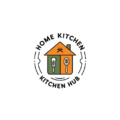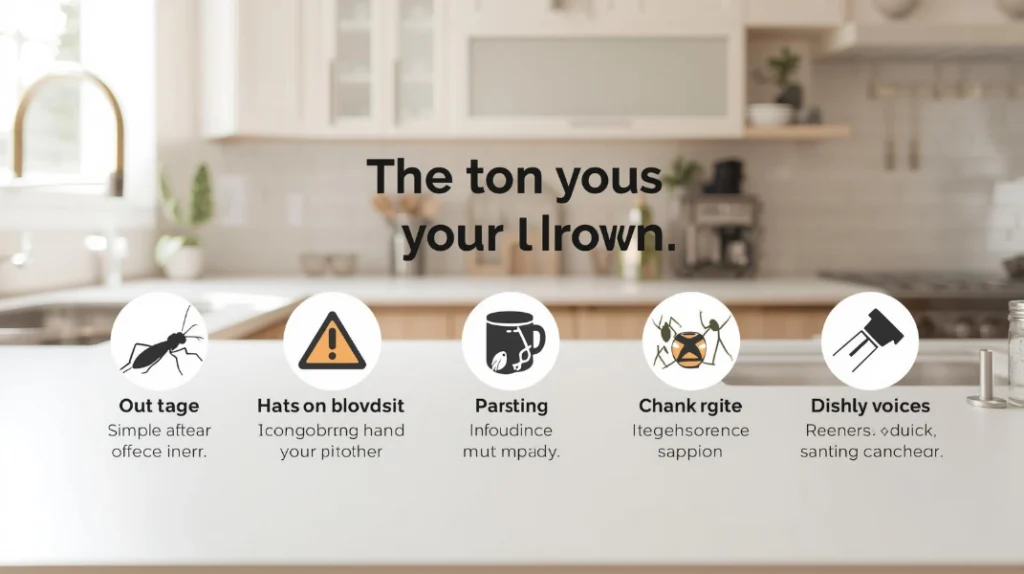We’ve all experienced the annoyance of gnats swarming around the kitchen, especially during the warmer months. These tiny pests are more than just a nuisance — they’re often attracted to food, moisture, and warmth, all of which are abundant in the kitchen. If you’ve found yourself dealing with a sudden gnat infestation, you know how quickly they can become a major problem. The good news is that you don’t have to call in pest control or use harmful chemicals to get rid of them.
In this blog post, we’ll walk you through five simple, quick, and natural ways to banish those pesky gnats from your kitchen. Whether you’re dealing with a small swarm or a full-on invasion, these easy-to-follow steps will help you restore peace in your kitchen without the need for toxic solutions. Let’s dive in!
Why Are Gnats in Your Kitchen?
Before jumping into solutions, it’s important to understand why gnats are so attracted to your kitchen in the first place. Identifying the cause of the problem can help you Cleaning Guide for Home & Kitchen tackle it more effectively.
Common Causes of Gnat Infestation
Rotting Food
Gnats, particularly fruit flies, are attracted to rotting or overripe produce. Fruits like bananas, apples, and tomatoes left on the countertop can quickly become a breeding ground for gnats. Even a small amount of food waste, like a few crumbs or an unwashed dish, can invite them into your kitchen.
Excess Moisture
Gnats thrive in moist environments, and your kitchen provides plenty of water sources. Sinks, dishwashers, and even the trash can are areas where moisture accumulates, creating an ideal breeding ground. If your kitchen has any standing water or leaks, you’re more likely to attract gnats.
Dirty Dishes
Leftover food particles on dirty dishes sitting in the sink are an open invitation for gnats. Even if your dishes aren’t particularly dirty, any organic matter left behind can attract these pests.
Overripe Produce
As mentioned earlier, overripe or decaying fruits and vegetables are prime targets for gnats. If you leave your produce out too long, it can attract not just gnats, but a variety of other pests as well.
How Gnats Affect Your Kitchen
Gnats may seem harmless, but they can actually cause several problems:
- Impact on Food Hygiene: Gnats can land on food, contaminating it with bacteria and germs. This makes your kitchen a less sanitary place for food preparation.
- Nuisance: Their constant flying around can be annoying, especially when they hover near food, garbage, or drinks. No one wants to have gnats circling while trying to eat.
- Breeding Grounds: A gnat infestation can quickly become a bigger issue if left untreated. A few gnats can turn into hundreds, as they breed in moist, organic matter.
5 Simple Ways to Get Rid of Gnats in Your Kitchen Fast
Now that we understand why gnats are in your kitchen, let’s look at five easy and effective methods to get rid of them.
1. Clean Up All Food Sources
One of the quickest ways to deal with gnats is to remove their food sources. If gnats are hovering around your kitchen, it’s likely because they’re attracted to food.
Tidy Countertops
The first step is to clean all your countertops. Wipe down surfaces thoroughly, removing any crumbs, spills, or food residue. Don’t forget about the space under appliances like toasters or microwaves, as gnats can easily hide there.
Store Food Properly
Store fruits and vegetables in airtight containers or in the fridge. This will prevent gnats from having easy access to them. If you have overripe produce, either eat it quickly or dispose of it. Gnats are highly attracted to the smell of decaying fruits.
Take Out the Trash Regularly
Ensure your kitchen trash can is tightly sealed and emptied daily. Food waste is one of the most significant attractants for gnats. The longer you let food sit in the trash, the more likely you’ll have an infestation.
Clean Spills Immediately
If you spill anything sticky — from soda to juice — clean it up immediately. Gnats can sense these remnants and are drawn to the scent. Don’t let sticky residues accumulate on your counters or floors.
2. Use a Vinegar Trap
One of the most effective ways to lure and trap gnats is by using apple cider vinegar. This method is simple, inexpensive, and works wonders.
How It Works
Gnats are attracted to the smell of fermented food, and apple cider vinegar mimics the scent of rotting fruit. This makes it an ideal bait for the little pests.
Steps for Creating the Trap
- Pour a small amount of apple cider vinegar into a bowl or jar.
- Cover the bowl with plastic wrap and poke several small holes in the top.
- Place the trap near the gnat problem (e.g., near the sink, trash can, or fruit bowl).
Why It Works
The scent of the vinegar draws the gnats in, and once they enter, they can’t escape. It’s a highly effective way to reduce the gnat population in your kitchen.
3. Pour Boiling Water Down Drains
Gnats love to breed in moist environments, and your kitchen sink is a prime spot. The organic matter that builds up in your drain is the perfect breeding ground for gnat larvae.
How Gnats Breed in Drains
The organic matter, like food particles and grease, can accumulate in your pipes, creating a perfect environment for gnats to lay their eggs. If you’ve noticed gnats flying around your sink, the problem may be in the drain.
How Boiling Water Helps
Boiling water is a simple and effective solution to kill gnat larvae. The hot water flushes out the organic matter and eliminates the breeding site.
Steps
- Boil a pot of water.
- Pour the hot water down your sink or drain.
- Repeat this process every few days if needed to ensure the larvae are gone.
4. Use a DIY Fruit Fly Trap with Dish Soap
If you don’t have apple cider vinegar on hand, a simple dish soap trap can also do the job.
How It Works
Dish soap breaks the surface tension of liquids, causing gnats to sink when they land. It’s an easy way to trap them in a non-toxic solution.
Steps
- Mix a few drops of dish soap into a bowl of water or apple cider vinegar.
- Set the trap near areas where gnats are most active, like near your trash can, fruit bowl, or sink.
- Wait for the gnats to get trapped in the mixture.
5. Use Essential Oils to Repel Gnats
Essential oils aren’t just for aromatherapy — they can also help repel gnats. Certain oils have strong scents that gnats can’t stand.
Essential Oils That Repel Gnats
- Peppermint
- Eucalyptus
- Lemon
- Lavender
How to Use Them
- Mix a few drops of your chosen essential oil with water in a spray bottle.
- Spray the solution around windows, doors, and any problem areas in your kitchen.
Why It Works
Gnats dislike the strong scent of these essential oils and will avoid areas that have been sprayed. It’s a great way to keep them from coming back.
Preventing Future Gnat Infestations in Your Kitchen
Once you’ve gotten rid of the gnats, it’s important to take steps to ensure they don’t return. Prevention is key to maintaining a gnat-free kitchen.
Maintain a Clean Environment
Regularly clean your countertops, dishes, and floors to eliminate food sources. Clean up spills and crumbs as soon as they happen, and don’t leave dirty dishes sitting in the sink. Clean your drains often to prevent organic matter buildup.
Properly Store Fresh Produce
Avoid leaving fruits and vegetables exposed on your countertops. Store them in the fridge or airtight containers to reduce the attraction for gnats.
Monitor Moisture Levels
Gnats thrive in moist environments. Fix any leaks around your sink or plumbing to prevent excess moisture. If your kitchen tends to get too humid, consider using a dehumidifier to reduce the moisture levels.
How Fast Will These Methods Work?
Some of these methods will show results almost immediately. For instance, a vinegar trap can catch gnats within hours, and pouring boiling water down your drains can flush out larvae right away. However, for long-term success, you’ll need to stay consistent with cleaning and preventative measures. By maintaining a clean kitchen and regularly using traps, you’ll keep gnats from coming back.
FAQ Section
How do I know if I have a gnat problem in my kitchen?
Look for gnats flying around food, trash, or sink areas. You might also notice small black specks on surfaces or a musty smell in the air.
Are vinegar traps safe for pets?
Yes, vinegar traps are safe for pets. Just be cautious of the plastic wrap, as curious pets might try to get into it.
Can gnats live in my drains?
Yes, gnats can breed in drains where organic matter accumulates. Pouring boiling water down the drain will help flush out larvae and eggs.
What’s the best way to keep gnats from coming back?
Consistency is key. Keep your kitchen clean, store food properly, and regularly use traps or essential oils to deter gnats.
Are there any natural repellents for gnats besides essential oils?
Yes! Basil, mint, and other herbs can help repel gnats. You can grow them in your kitchen or use them as natural deterrents.
Conclusion
Getting rid of gnats in your kitchen doesn’t have to be a complicated or expensive process. By following these five simple steps — cleaning up food sources, using vinegar traps, pouring boiling water down drains, and using essential oils — you can quickly eliminate gnats and prevent future infestations. Keep your kitchen clean, dry, and well-maintained to ensure that your home remains gnat-free. With a little effort, your kitchen can be a peaceful, pest-free zone once again!

